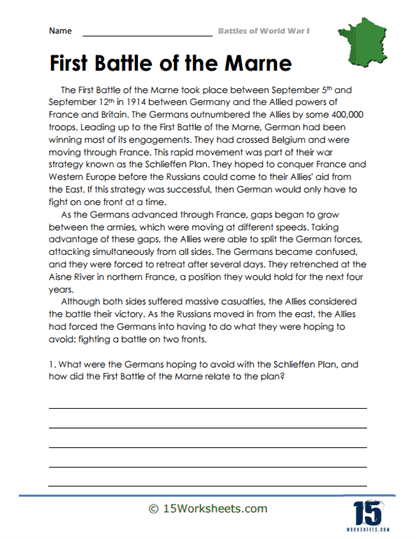First Battle of the Marne

Worksheet Description
This worksheet delves into the First Battle of the Marne, which transpired between September 5th and September 12th in 1914, marking a crucial confrontation between Germany and the Allied powers during World War I. The text elaborates on the circumstances leading to the battle, notably Germany’s Schlieffen Plan, their intent to swiftly conquer France, and the tactical implications of this strategy. As the Germans progressed through France, unexpected challenges arose due to the differing movement speeds of armies, culminating in the German retreat to the Aisne River. Additionally, the worksheet touches upon the considerable casualties of both sides and the long-term strategic implications of the battle.
To adeptly tackle this worksheet, students should start by reading the provided content thoroughly, ensuring a comprehensive understanding of the events, strategies, and outcomes associated with the First Battle of the Marne. They should pay close attention to the motives and tactics of Germany, especially the Schlieffen Plan, and how it connected to the eventual unfolding of the battle. Once the main ideas are grasped, students should ponder the question posed at the bottom, linking the Schlieffen Plan to the events and outcomes of the battle. When answering, students ought to utilize information from the text, offering a well-reasoned and evidence-backed response.
The primary objective of this worksheet is to foster a deeper understanding of the complexities and intricacies of World War I battles, using the First Battle of the Marne as a focal point. By highlighting Germany’s strategy and the unforeseen challenges they encountered, students are encouraged to reflect on the unpredictability of war and the ramifications of strategic decisions. Additionally, the worksheet endeavors to underscore the importance of adaptability in warfare, as evidenced by the German army’s need to adjust their plans based on the evolving situation. In essence, this educational tool seeks to hone students’ analytical and comprehension skills while providing them with a richer perspective on a pivotal World War I event.
